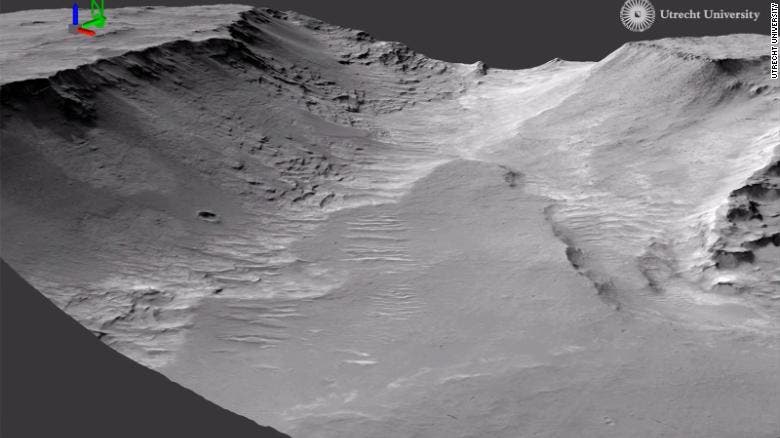Despite now being unhospitable, Mars’s surface was once covered in water in different forms, from rivers to even a huge ocean. Understanding the history behind the red planet and how it lost its water has long been a focus of researchers. Cutting-edge technology is now bringing them closer to that goal.

An international group of researchers used images and topography data captured by NASA’s Mars Reconnaissance Orbiter’s HiRISE camera to study a rim of the Hellas Basin in Mars’ southern hemisphere – which had long been of interest as it’s one of the largest in the solar system.
The team narrowed its focus to a rocky cliff roughly 656 feet high that’s about 3.7 billion years old that’s part of this basin. Composed of sediment accumulated over time, its rocks are like the rocks found on Earth’s rivers. The high-resolution images reveal that it was formed by rivers more than 3.7 billion years ago.
These exposed cliff faces on Mars reveal “rivers that continuously shifted their gullies, creating sandbanks, similar to the Rhine or the rivers that you can find in Northern Italy,” the researchers said in their study.
The sedimentary rocks record layers of history, and the researchers were able to determine that the channels of these ancient rivers were around 9 or 10 feet, or several meters, deep.
Analyzing these layers on Mars can shed more light on its history, much like geologists used sediment layers on Earth to understand how our planet evolved over time and envision what it was like millions and billions of years ago, the researchers argued.
William McMahon, co-lead author of the paper, said in a statement: “Here on Earth, sedimentary rocks have been used by geologists for generations to place constraints on what conditions were like on our planet millions or even billions of years ago. Now we have the technology to extend this methodology to another terrestrial planet.”
The rocks studied by the team can only tell us about a fraction of the time that water and sediment were being moved in the region because erosion erased whole layers of its geologic history. But other rocks acting as markers of time could yet be undiscovered or buried, they said.
Based on the evidence they found in the orbital data, the researchers believe that the planet’s water cycle was driven by precipitation, like the rain we experience on Earth, and that liquid water had a sustained presence 3.7 billion years ago.
“We’ve never seen an outcrop with this amount of detail on it that we can definitely say is so old. This is one more piece of the puzzle in the search for ancient life on Mars, providing novel insight into just how much water occupied these ancient landscapes,” Joel Davis, co-author, said in a statement.
In 2022, the European Space Agency (ESA) is due to launch the Rosalind Franklin ExoMars rover, which will explore similar terrains to determine whether there has ever been life on Mars and to better understand the history of water on the planet. The researchers will help to interpret the findings.
The findings were published in the journal Nature Communications.






